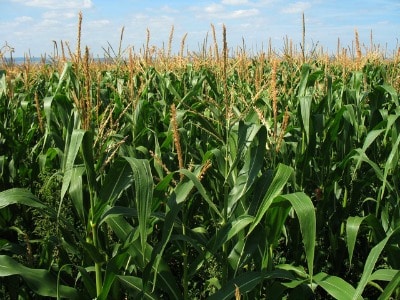Transpiration in plants has been described as a necessary evil.
This is mainly because the process involves the loss of large amounts of water.
The volume of water transpired is considered lost because it is not used by the plant for its life processes.
It consists of a major portion of the water that is absorbed by plants and which simply escapes outward.
The “evil” is necessary because transpiration occurs largely as a natural consequence of the opening of the stomata which is essential in photosynthesis.
Major loss of water is through the stomatal pores when they open to facilitate the entry of carbon dioxide for photosynthesis and the release of oxygen which is generated in the photolysis of water.
It may be possible to stop stomatal transpiration by inducing the closure of the stomata but it will also mean putting a stop to photosynthesis.
How Much Water Lost in the Process of Transpiration in Plants
But how much water is exactly lost in the process of transpiration in plants?
Many factors affect plant transpiration including plant species and the elements of climate. Nonetheless, the following data and calculations will help to shed light.
Citing Ferry and Ward (1957), Devlin (1975) provided some quantified data on the rates of transpiration in plants.
Accordingly, the following crop plants are capable of losing these much amounts of water by transpiration in one growing season per single plant (in a gallon): corn – 54, tomato- 34, winter wheat – 25, Irish potato – 25, and cowpea – 13 (please take note of the word “capable“.
In comparison, according to Hopkins (1999), the rate of transpiration of a single 14.5-meter silver maple tree that grows in the open sun may be up to 225 liters (about 59 gallons) of water per hour.

For corn, the given water loss (54 gallons per plant per season) is equivalent to 204.4 liters.
This is about the same as the 200 liters reported by E. C. Miller in 1938 (cited by Hopkins 1999).
54 gal/plant x 3.78541 li/gal = 204.4 li/plant in one growing season
Therefore, if (assuming) the growing season for corn is 110 days, each corn plant will have a daily transpirational loss of 1.86 liters of water on average.
204.4 li/plant ÷ 110 days = 1.86 li/plant/day
Interestingly, the calculated average of 1.86 liters is close to the minimum basis given by Went and The Editors of Life (1963).
According to the authors, a single corn plant transpires more than two quarts, equivalent to about 1.89 liters, in one day.
By multiplying 1.89 li by 110 days, the total loss of water will amount to 207.9 li.
This is likewise close to the volume (204.4 li) derived from Devlin’s (1975) data as shown above.
Total loss of water by transpiration from a single plant in one growing season = 1.89 li/day x 110 days = 207.9 li
As to the maximum, Moore et al. (2003) provided that a single corn plant transpired almost 500 liters of water during a 4-month growing period.
By dividing 500 li by 120 days (total number of days in 4 months), the average volume of water that a single corn plant transpires is about 4.2 liters in one day.
Interestingly, each human needs about the same volume of 2-4 liters of water daily (click to read source page).
Many factors affect the rate of transpiration in plants including the availability of soil water.
But assuming, for the sake of further elaboration on the importance of transpiration in plants and in crop agriculture, that the daily water loss by transpiration of more than 1.89 liters per plant holds true, consider the following calculation:
If corn is planted in a single-row method spaced 70 cm (= 0.70 m) between adjacent rows and 25 cm (= 0.25 m) between hills at one plant per hill, the calculated population density will be 57,142.8.
Multiplied by 207.9 liters, the computed volume of water transpired by a single corn plant throughout its growing season, the total volume of the transpirational loss of water will be about 11.88 million liters per hectare in only one growing season!
Here’s the calculation:
Population Density = 10,000 m2/ha ÷ (0.70 m x 0.25 m) = 57,142.8 plants/ha
Total volume of water loss per hectare = 57,142.8 plants/ha x 207.9 li/plant = 11,879,988.1 li/ha or about 11.88 million liters in one hectare
Assuming further that corn yield is 10 tons or 10,000 kg of grains per hectare in one season, it would appear that at least 1,188 liters of water (313.8 US gallons) is lost in producing one kilogram of corn grains.
Water transpired per kg of corn grains produced = 11,879,988.1 li/ha ÷10,000 kg/ha = 1,187.9 li ≅ 1,188 li/kg
This is without regard to other losses of water like evaporative loss from ground surfaces and percolation.
The proportionate contribution of water to other biological yields of the corn plant is also disregarded.
Quite similarly, it has been determined that some 1,000-3,000 liters of water are needed to produce one kilogram of rice (click here to read the source page).
The above derivations should be considered mathematical evidence of the extreme importance of transpiration in plants and humans.
Consequently, man ought to be frugal in his use -and wasting- of this precious substance called water.
Indeed, plants can survive without humans, but allow humans to monopolize water to such an extent that plants are totally deprived and shall die.
And without any beckoning, the rest of humanity will soon follow.
Conversion equivalents used:
- 1 US gallon = 3.78541 liters
- 1 US quart = 0.946353 liter
- 1 hectare = 2.47105 acre = 10,000 m2
